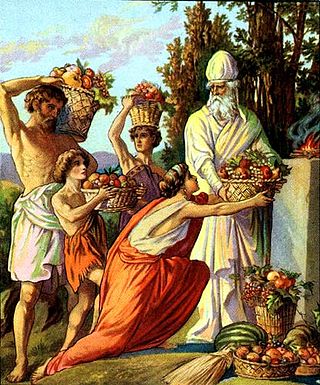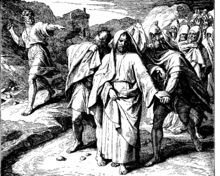
Draco Lucius Malfoy is a fictional character and a major antagonist in J. K. Rowling's Harry Potter series. He is a student in Harry Potter's year belonging in the Slytherin house. He is frequently accompanied by his two cronies, Vincent Crabbe and Gregory Goyle, who act as henchmen. Draco is characterised as a cowardly bully who tricks and hurts people to get what he wants; he is also a cunning user of magic. He was played by Tom Felton in the Harry Potter film series.

The Curse of the Bambino was a superstitious sports curse in Major League Baseball (MLB) derived from the 86-year championship drought of the Boston Red Sox between 1918 and 2004. The superstition was named after Babe Ruth, colloquially known as "The Bambino", who played for the Red Sox until he was sold to the New York Yankees in 1920. While some fans took the curse seriously, most used the expression in a tongue-in-cheek manner.
A jinx, in popular superstition and folklore, is a curse or the attribute of attracting bad or negative luck.
In J. K. Rowling's Harry Potter series, magic is depicted as a supernatural force that can be used to override the usual laws of nature. Many fictional magical creatures exist in the series, while ordinary creatures sometimes exhibit magical properties. Magical objects are also described. Witches and wizards refer to the rest of the population, who are generally unaware of magic, as "Muggles" in the United Kingdom and "No-Maj" in the United States.

The Nephilim are mysterious beings or people in the Hebrew Bible who are described as being large and strong. The Hebrew word Nephilim means "giants"; some understand it to mean "the fallen ones" but this is a misunderstanding of the Hebrew. Their origins are disputed. Some, including the author of the Book of Enoch, view them as offspring of fallen angels and humans. Others view them as offspring of the descendants of Seth and Cain.

The Cubs–White Sox rivalry refers to the Major League Baseball (MLB) geographical rivalry between the Chicago Cubs and Chicago White Sox. The Cubs are a member club of MLB's National League (NL) Central division, and play their home games at Wrigley Field, located on Chicago's North Side. The White Sox are a member club of MLB's American League (AL) Central division, and play their home games at Guaranteed Rate Field, located on Chicago's South Side.

An incantation, a spell, a charm, an enchantment, or a bewitchery, is a magical formula intended to trigger a magical effect on a person or objects. The formula can be spoken, sung, or chanted. An incantation can also be performed during ceremonial rituals or prayers. In the world of magic, wizards, witches, and fairies are common performers of incantations in culture and folklore.

Friday the 13th: The Series is a television series that ran for three seasons, from October 3, 1987, to May 26, 1990, in first-run syndication. The series follows Micki and Ryan, cousins who inherit an antiques store; after selling all the antiques, they learn from Jack Marshak that the items are cursed. The trio then work together to recover the objects and return them to the safety of the shop's vault.

Samyaza, also Shamhazai, Azza, Uzza or Ouza, is a fallen angel of apocryphal Abrahamic traditions and Manichaeism as the leader of the Watchers.

Angelique Bouchard is a fictional character from the gothic horror-soap opera and film Dark Shadows, in which she is the main antagonist. She is primarily portrayed as a powerful witch, who is driven by her vacillating love and hatred for Barnabas Collins.

Ki Tavo, Ki Thavo, Ki Tabo, Ki Thabo, or Ki Savo is the 50th weekly Torah portion in the annual Jewish cycle of Torah reading and the seventh in the Book of Deuteronomy. It comprises Deuteronomy 26:1–29:8. The parashah tells of the ceremony of the first fruits, tithes, and the blessings from observance and curses from violation of the law.

The Curse of the Colonel was a 1985 Japanese urban legend regarding a reputed sports curse placed on the Japanese Kansai-based Hanshin Tigers baseball team by the ghost of deceased KFC founder and mascot Colonel Sanders.
A sports-related curse is a superstitious belief in the effective action of some malevolent power, that is used to explain the failures or misfortunes of specific sports teams, players, or even cities. Teams, players, and cities often cite a "curse" for many negative things, such as their inability to win a sports championship, or unexpected injuries.
Ancestral sin, generational sin, or ancestral fault, is the doctrine that individuals inherit the judgement for the sin of their ancestors. It exists primarily as a concept in Mediterranean religions ; generational sin is referenced in the Bible in Exodus 20:5.

Nanashi no Game is a first-person survival horror video game developed by Epics and published by Square Enix for the Nintendo DS. The game follows a university student who becomes cursed by the role-playing game in the title, which causes people to die in seven days upon starting. It was released on July 3, 2008, in Japan. A sequel, titled Nanashi no Game: Me, was later released on August 27, 2009, in Japan, followed by another sequel in 2012.
The Curse of Coogan's Bluff (1958–2010) was a baseball-related superstition that allegedly prevented the San Francisco Giants Major League Baseball franchise from winning the World Series following the club's move from New York City to San Francisco after the conclusion of the 1957 season. The curse began when upset Giants fans in the New York metropolitan area placed a hex on the relocated franchise. The curse proved true in the World Series of 1962, 1989, and 2002. It ended when the Giants won the 2010 World Series in their fourth World Series appearance since the move to San Francisco.

Lufia: Curse of the Sinistrals, released as Estpolis: The Lands Cursed by the Gods (エストポリス) in Japan, is an action role-playing game video game co-developed by Neverland and Square Enix for the Nintendo DS. It is a remake of the 1995 Super Nintendo Entertainment System game Lufia II: Rise of the Sinistrals, also developed by Neverland. The character re-designs are by former Square Enix character designer, Yusuke Naora.
Kodoku, also called kodō, kojutsu, and fuko is a type of poisonous magic found in Japanese folklore. It is the Japanese derivative of the Chinese gu magic.

The Land of Stories is a series of children's fiction, adventure and fantasy books written by American author, actor and singer Chris Colfer. The first book, The Wishing Spell, was released on July 17, 2012. The sixth book was published in July 2017. Colfer started plans for a prequel series in 2016, and has since published three books in this prequel series beginning with A Tale of Magic... in 2019.

Galatians 3 is the third chapter of the Epistle to the Galatians in the New Testament of the Christian Bible. It is authored by Paul the Apostle for the churches in Galatia, written between 49–58 AD. This chapter contains Paul's important argument about Abraham's faith and his 'offspring', a designation for "those belong to Jesus Christ".



















